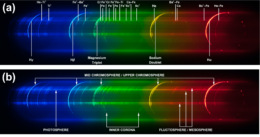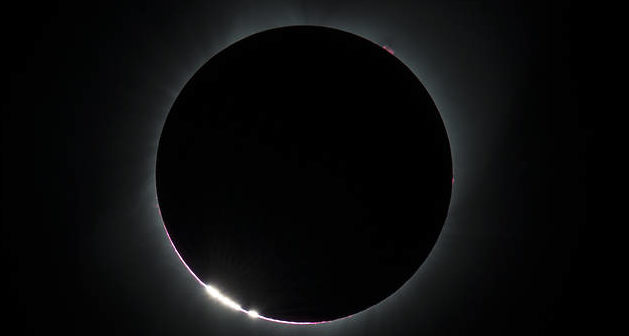How big is the Sun when seen from Earth? Though it may seem like a simple question, it’s important for predicting when exactly a total solar eclipse will occur. Using data from the 2017 total solar eclipse, a group of amateur astronomers have recalculated a measurement that hasn’t been updated in more than a century.
Timing Totality
Solar eclipses provide a unique opportunity to study the Sun’s outer layers (which are usually hidden), the structure of the Moon, and even general relativity. Determining the precise moment a solar eclipse will happen is crucial to these scientific endeavors, and the most accurate way to predict when totality will occur is by determining the exact radius of the Sun so we know when it will be fully covered by the Moon.

The path of the total solar eclipse just south of Vale, Oregon. Click to enlarge. [Quaglia et al. 2021]

The spectrum of elements in the different layers of the Sun during the flash spectrum. Panel (a) shows the different elements and (b) shows which layer the elements belong to. Click to enlarge. [Adapted from Quaglia et al. 2021]
Eclipsed Elements
Though the Sun is mostly made of hydrogen, traces of other elements are present. When the overwhelming glare of the Sun’s disk is blocked out during an eclipse, emission lines from these elements become visible, arising from the Sun’s fainter outer layers. Different layers of the Sun have different abundances of these elements, so a spectrum taken during a total solar eclipse changes as the photosphere, chromosphere, and inner corona come into view.
From their vantage point at the edge of the eclipse’s path, Quaglia and collaborators captured a video of the eclipse and extracted a spectrum from the moments seconds before and after totality when the chromosphere briefly becomes visible. From the video, they detect when the photosphere spectrum appears and disappears and use that to estimate how long the Sun is in the Moon’s shadow, which helps estimate the radius.
Lunarious Light Curves
After observing the spectrum, the team employed another method to calculate the eclipse solar radius: using the light curves obtained during the solar eclipse and comparing them to models. Precise eclipse calculations depend not only on the Sun’s radius but also on getting the positions of the Earth, Moon, and center of the Sun using the latest ephemeris and modeling the surface of the Moon correctly.

The average lunar surface (green) versus the model (black). The discrepancies on the surface are magnified by 100x so the peaks and valleys can be highlighted. [Quaglia et al. 2021]
The team was able to estimate the eclipse solar radius value to within a tenth of an arcsecond, showing that it’s slightly larger than the standard solar radius value used for the last 100 years. During the next total solar eclipse in 2023 in Western Australia, the authors hope to record a higher-resolution flash spectrum video of the Sun to better constrain their estimate.
Bonus
Check out the video below that shows the momentary “flash spectrum” captured by Quaglia and collaborators when the chromosphere was briefly visible during the August 2017 eclipse.
Citation
“Estimation of the Eclipse Solar Radius by Flash Spectrum Video Analysis,” Luca Quaglia et al 2021 ApJS 256 2. doi:10.3847/1538-4365/ac1279

